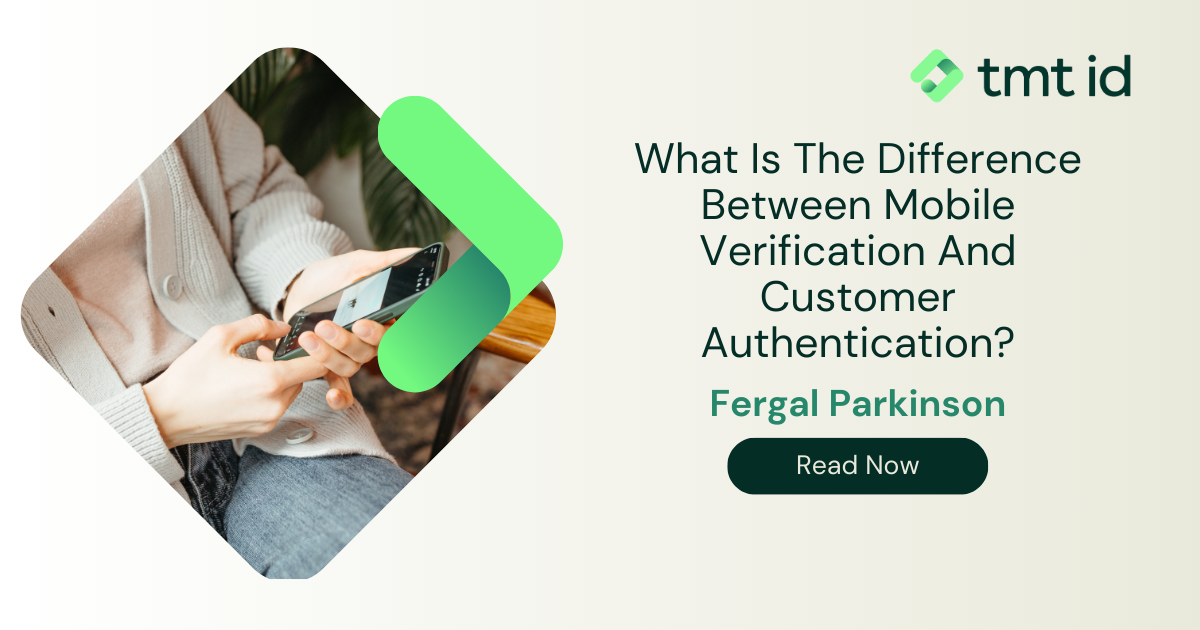
Protecting your business and customers from the risks of online fraud requires a multi-faceted approach. Not only are there many important measures businesses must take to remain compliant with national and international legislation, it’s also increasingly important to provide your customers with reassurance and trust as they undertake more of their daily activities online.
![]()
In the USA alone, customers accessing their online banking via a mobile device has grown to over 203 million in 2022, up by over 4 million compared to the year before. As users become increasingly familiar with accessing their personal information using a mobile phone, their risks of becoming a victim of online fraud also increase.
As a business you need to make sure that you’re taking advantage of all opportunities available to keep customers safe, without impacting their user experience by adding friction to your login and/or digital onboarding processes.
Both mobile verification and customer authentication are import tools in providing a safe and secure digital environment. Through seamlessly integrating both types of data checks into your existing processes you can both provide additional protection and an effortless customer experience – all through our suite of clever API’s.
The aim of this article is to explain the differences in these two types of checks and the overall benefits they can add to your business, through providing additional online security to your new and existing users.
Customer mobile number verification is an important method of data validation, confirming that an individual is who they say they are when creating a digital account or trying to log in as a returning customer.
Confirming a customer’s identity is not only an important factor for your business, but in most cases it’s also a legal requirement depending on the locations in which you’re operating. Industries such as online banking also have a legal obligation to carry out specific Anti Money Laundering (AML) checks and Know Your Customer (KYC) checks to help prevent and protect from fraud.
![]()
Customer mobile number validation plays an important part in these respective customer identification checks for several reasons, including:
A customer mobile phone number is amongst one of the most consistent and reliable datapoints about them, meaning that it can be used to confirm whether they are who they are claiming to be. This is done through checking aspects like device location and connected network
Our API lookup tools cross reference trusted global data sets, provided directly from organisations such as mobile network operators and government departments. This means it is extremely hard to manipulate or forge.
Using a customer mobile phone number for validation is a fully digital process and reduces the need for customers to provide additional information, such as ID photographs or proof of address.
All our products can be integrated into your existing digital onboarding, KYC and AML processes, meaning that there is no additional friction applied and your customer experience is not impacted. Each lookup can be done in less than a second!
Mobile number validation can also help improve the return on your marketing spend. Through streamlining your digital onboarding process, it is possible to see a significant reduction in your sign-up abandonment rates, improving your overall customer acquisition costs from your wider marketing strategy.
Additionally, you can also use our Live API to validate the mobile numbers in your marketing database by checking if a mobile number is active and real before sending out your SMS marketing campaigns. For global companies messaging marketing information or account validation codes, improving your send success rates can have a significant impact on your overall costs and return on investment.

Customer authentication is the process of verifying a customer’s identity to ensure that they are who they claim to be before allowing them to access certain transactions or especially sensitive features within your application or web platform. This is usually validated with a one-time authentication, ‘OAUTH’ code or passcode, which grants them access to finish the financial transaction or similar process they are undertaking online.
The main difference between customer authentication and mobile phone number verification is it the focus for authentication is granting permissions for specific transactions, whereas mobile verification is designed to confirm a person’s identity through validating the details provided against the data held by the network operator in question.
Although different, both play an important role in keeping your customer protected from online fraud and work closely together, particularly for financially focused operations such as banks and financial services, gaming companies and cryptocurrency exchanges – where there is a higher risk of online attacks.
Although customer authentication is essential to provide additional online security, it can also be a cumbersome process when your customers need to access their devices or check emails to hunt down authentication codes. Particularly so if the emails or texts are delayed in sending due to an unreliable provider!
Through our latest customer authentication product, businesses can now carry out fully integrated and frictionless checks as part of the existing transaction process within your business application.
This is also known as ‘Silent Authentication’ due to the fact it has no impact on your customer experience and takes place in the background, based on a user’s mobile device credentials. This process can be carried out in a matter of seconds and there are multiple authentication layers a user must past through, making this extremely secure and almost impossible to fake.
One of the most prominent risks to your customers online comes from phishing attacks, or instances where hackers and fraudsters send out fake messages to try and solicit users to click on a link. A cloned, fake website then encourages them hand over personal information, such as banking details or credit card credentials.
Dated SMS messaging technology is extremely vulnerable to being used by criminal to carry out these attacks. By using silent authentication, you are removing the need for your business to send out authentication codes via SMS text message and email, meaning that you are also greatly reducing the risks of this specific type of online fraud.
It is possible to integrate our Authenticate API into nearly all existing application development languages and we have a specialist team on hand to help with this process. Our platform also only uses one interface for all mobile networks globally, meaning that you’ll only need to undertake this technical deployment once. We can also fit our checks seamlessly into the stages of your existing workflows or processes.
Silent authentication is possible on all devices regardless of manufacturer and operating system. It is also fully achievable on older mobile phones as it only requires an active internet connection, which can make contact with the authentication URL and grant access. This process also has a minimal impact on your customer’s overall data usage.

It’s a difficult question to answer as both play a different role in the provision of a fully secure online environment for your customers.
Mobile verification provides the future for frictionless customer ID verification, something which is of increasing importance as your digital customers grow and so do the regulations designed to protect them from fraud online. Silent customer authentication allows you to provide full security compliance in a seamless way, giving peace of mind to your customers as they access their personal information online.
A futureproofed business focussed on protecting their customers should really be adopting both as part of their overall online fraud prevention strategy. TMT Analysis offer a powerful suite of API tools which are specifically designed to carry out these checks and protect your customers from fraud, without adding friction to your journey into a digital future.
Speak to us today and see how we can help transform your fraud prevention infrastructure.
Last updated on April 30, 2025



We provide the most comprehensive device, network and mobile numbering data available
Contact us > Chat to an expert >